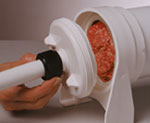
11. After you've packed the freshly mixed sausage meat into the cylinder, screw the head cover into the sausage stuffer.
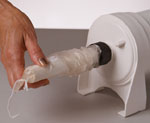
12. Slide a prepared fibrous sausage casing onto the sausage tube.
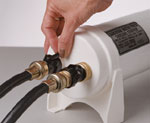
13. Double check to make sure the drain valve on the back of the sausage stuffer is off. Crack open the intake valve until you see or hear water running into the sausage stuffer.
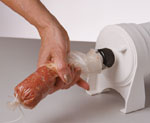
14. Slower is better as minimal water pressure forces the meat forward and out the sausage tube and into the casing.
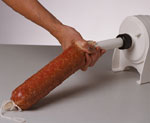
15. Hold the casing tightly and keep the end of the sausage tube buried into the meat while as you fill the casing.
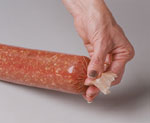
16. Continue to fill the fibrous casing until there is and inch remaining.
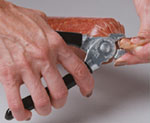
17. Tie off the casing with butcher twine or crimp with a hog ring. Continue the same procedure with the rest of the meat.
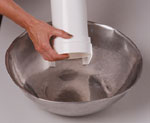
18. Unscrew the sausage stuffer headcover and tip the cylinder downward into a sink or bucket. Crack open the shutoff valve and use the water to push the piston out of the cylinder.
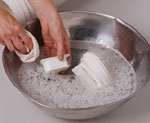
19. Shut off the water, unhook the hoses, disassemble and clean your Dakotah Sausage Stuffer with hot soapy water. Do NOT wash in dishwasher.
| 
The Dakotah Sausage Stuffer operates on minimal water pressure (as little as 15# PSI). Precision injected to exact tolerances from food-grade ABS plastic. Listed as a 10 lb. capacity sausage stuffer. One person operation!
For maximum performance always stuff your sausage casings immediately after mixing the ground sausage meat and fat (if it is wild game) together with the sausage seasoning, binder, salt, water and Prague Powder (curing salt). If the sausage mixture should set up and stiffen, add more water and remix until it is again soft and pliable. This will make it easier to stuff and increase the life of your Dakotah Sausage Stuffer.
Using the sausage meat mixture immediately after it is mixed with the sausage making ingredients should be the rule of thumb for any sausage machine including the horizontal sausage stuffer and the upright stainless steel sausage stuffers as well as the rest of the sausage stuffers available today. Gears can break on any sausage stuffer when the sausage mixture is has set up overnight or is too dry!
If you are making sausage with an electric meat grinder or a manual meat grinder, on the other hand, regardless of the brand name, the sausage meat mixture should be allowed to set up overnight so that it is easier to get through the meat grinder. And let's not forget that meat grinders were not built for stuffing sausage into sausage casings! They were built to grind meat.
All sausage meat including beef, pork, venison (deer, elk) and fat to be used for making sausage should be fresh or fresh frozen and thawed. For the best results make your fresh or smoked sausage in a clean and cool environment. Temperatures from 34 to 38 degrees is preferred for sausage making. Refrigerate the sausage immediately after it is mixed and stuffed into the sausage casing. The same rule applies for fresh bulk sausage. Meat Preparation Tips:
When you're trimming beef and pork for meat to make sausage, cut away as much gristle and tendon as you can. If you want a sausage link that is leaner than most store-bought sausage cut away as much of the outside fat from the meat as you think necessary. I prefer beef chuck, minus the outside fat, for pepperoni, salami and summer sausage recipes while lean pork trimmings make the best fresh sausage such as Italian, bratwurst and breakfast sausage links.
When I'm working with deer meat, my formula for smoked deer sausage and smoked deer snack sticks is 80% lean deer to 20% lean pork trim for salami, summer sausage, and thuringer type sausages. This combination may be too lean for some but it's definitely healthier for you.
Unlike beef and pork, venison (deer and elk) has tallow instead of fat. Tallow taints quickly and should be trimmed and discarded. Tallow also tends to stick to the roof of your mouth and tallow that is tainted will ruin your sausage.
My formula for fresh deer style sausage is 50% lean pork trim to 50% lean venison which is about half the fat in most store-bought pork sausage links. When you fry a sausage patty or sausage link using my 50% to 50% fat-to-lean ratio you'll have enough fat for a moist sausage patty, providing the sausage patty is not overcooked, and it won't be swimming in an inch of grease like the majority of most store-bought sausage patties or sausage links.
I use the above fat-to-lean ratio for smoked sausage links as well. This fat-to-lean ratio produces a meaty sausage link that's much healthier than store-bought sausage links. Commercial smoked sausage links may contain as much as 20% to 30% fat.
Another advantage when you make your own homemade sausage is that you have total control of what goes in your sausage recipe. You can reduce or increase the amount of fat and you choose the meat. You can also reduce the amount of salt, at least to a certain extent. Too little salt produces a bland sausage whether you are making fresh sausage or smoked sausage. Experiment with different sausage seasonings and sausage spices until you create a beef sausage recipe or venison sausage recipe that suits your particular taste.
My formula for smoked deer sausage links such as summer, salami, thuringer etc. is 80% lean to 20% lean pork trim. This combination produces an excellent sausage with a great texture and taste. However, if you're into the commercial beef sausage and like your sausage fatty, my formula will likely be too lean to suit you. Experiment with sausage making until you come up with a formula that works for you. Experiment with different beef sausage recipes and venison sausage recipes as well. The more sausage you make the better it will become.
The most popular sausage casings used by home sausage makers including natural hog casings and natural sheep casings. Hog casings come in a variety of sizes with the most popular being 32-35MM which is commonly used for Polish Kielbasa, Italian Sausage, Bratwurst, Chorizo, , Bologna/Franks, Traditional Pork Sausage Links and more. Sheep casing in the 22-24mm size is used to make Maple Flavored Breakfast Sausage links and other small diameter sausages. Natural casings are edible and don't have to be peeled away before eating the sausage.
Hog and sheep casings are generally sold to the home sausage maker by the home pack size or hank. The amount you can stuff with a home pack size of natural hog casings is 25 pounds. A home pack size sheep casing will stuff 15 lbs.
A hank of hog casings is enough to stuff 100-110 lbs. of sausage links and a hank of sheep casing is enough to stuff about 70 lbs. of breakfast sausage links.
Fibrous casings are non-edible and we sell them a clear, 2 1/2 inch by 20 inch casing. We also have the 2 1/2 inch by 20 inch fibrous casing in a pre-printed (venison) mahogany colored casing.
We sell our collagen casings in 19 mm diameter tubes that are 50 feet long. Use the 19mm for beef or venison snack sticks.
|
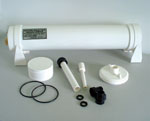
1. Remove the sausage stuffer parts from the box. Instructions included.
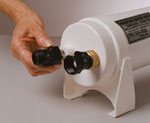
2. Screw on the black shutoff valves to the rear of the sausage stuffer.
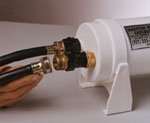
3. Attach a short garden hose (6 ft.) to each shutoff valve at the back of the sausage stuffer.
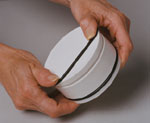
4. Stretch the O-rings over the sausage stuffer piston and pop into the grooves as shown in the picture
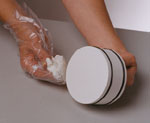
5. Lubricate the sausage stuffer piston and the mouth of the sausage stuffer cylinder with vegetable oil or shortening. Do not use food-grade grease or silicone as a lubricant.
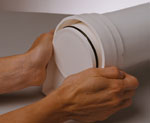
6. Insert the sausage stuffer piston into the cylinder with the flat side of the piston facing outward.
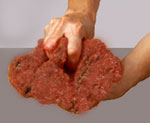
7. Mix & knead the ground meat, water and sausage seasoning together until you obtain a soft pliable sausage mixture. For the best results use fresh beef, pork or venison.
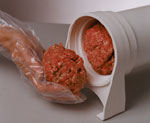
8. Push the piston to the rear of the Dakotah Sausage Stuffer. Pack the cylinder with freshly mixed (squishy) sausage meat.
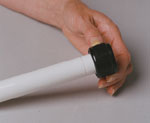
9. Slide one of the sausage tubes (3/8" or 3/4") into the black coupler until it locks into place on the tube.
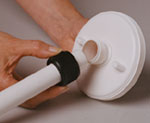
10. After the sausage tube is secured by the lock nut groove, screw the sausage tube & nut assembly onto the sausage stuffer headcover as seen in the above photograph.
|



















